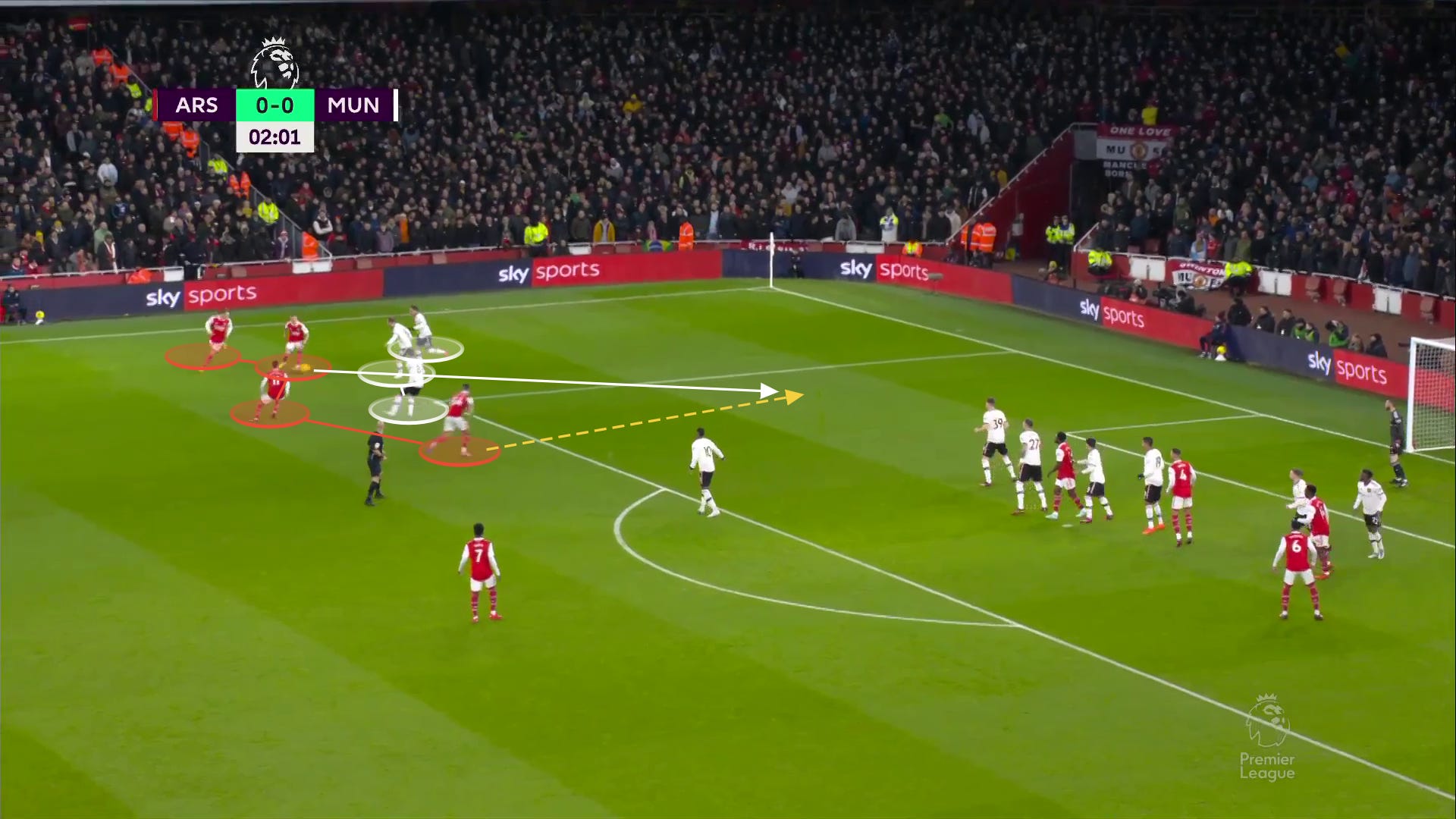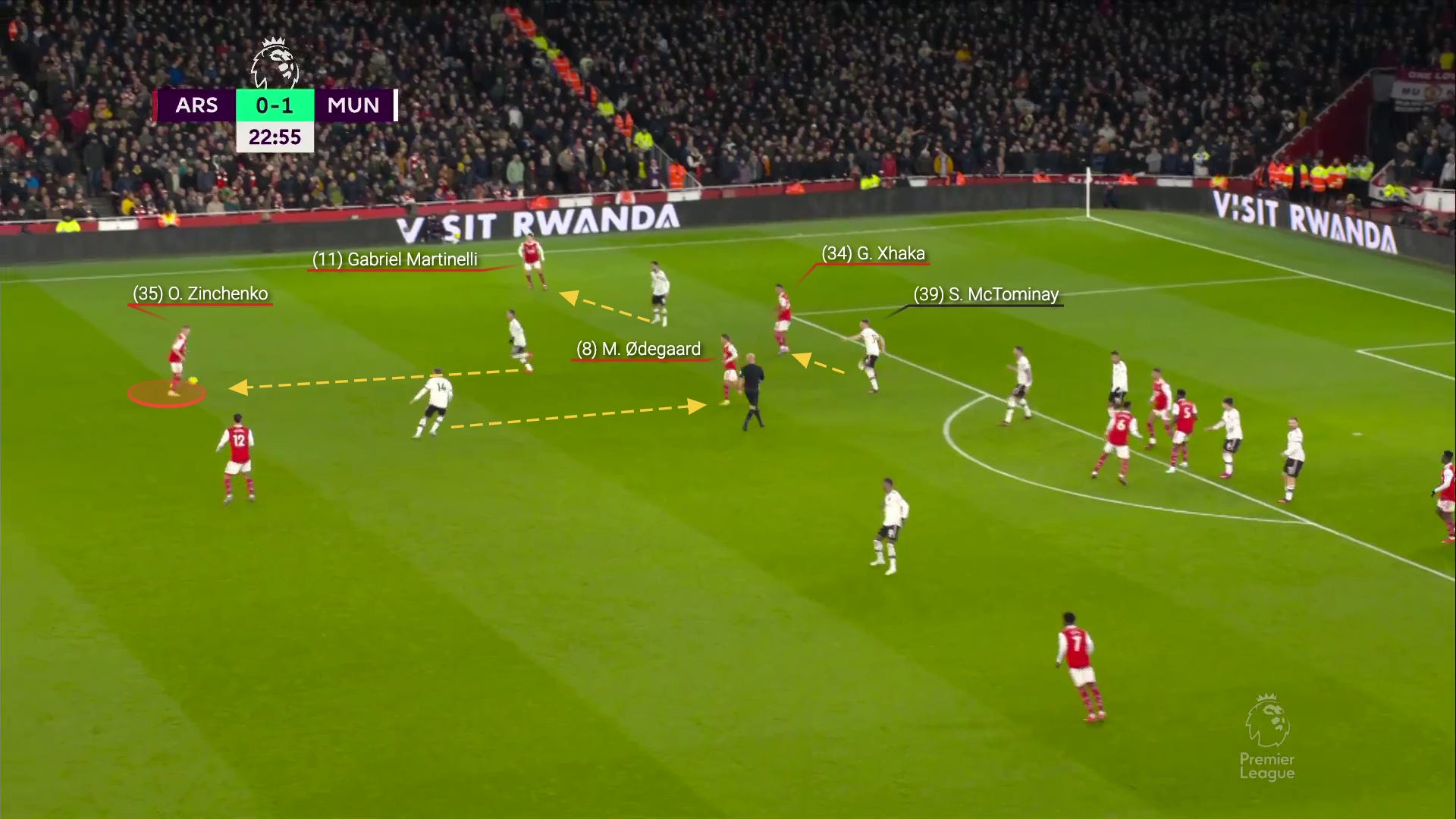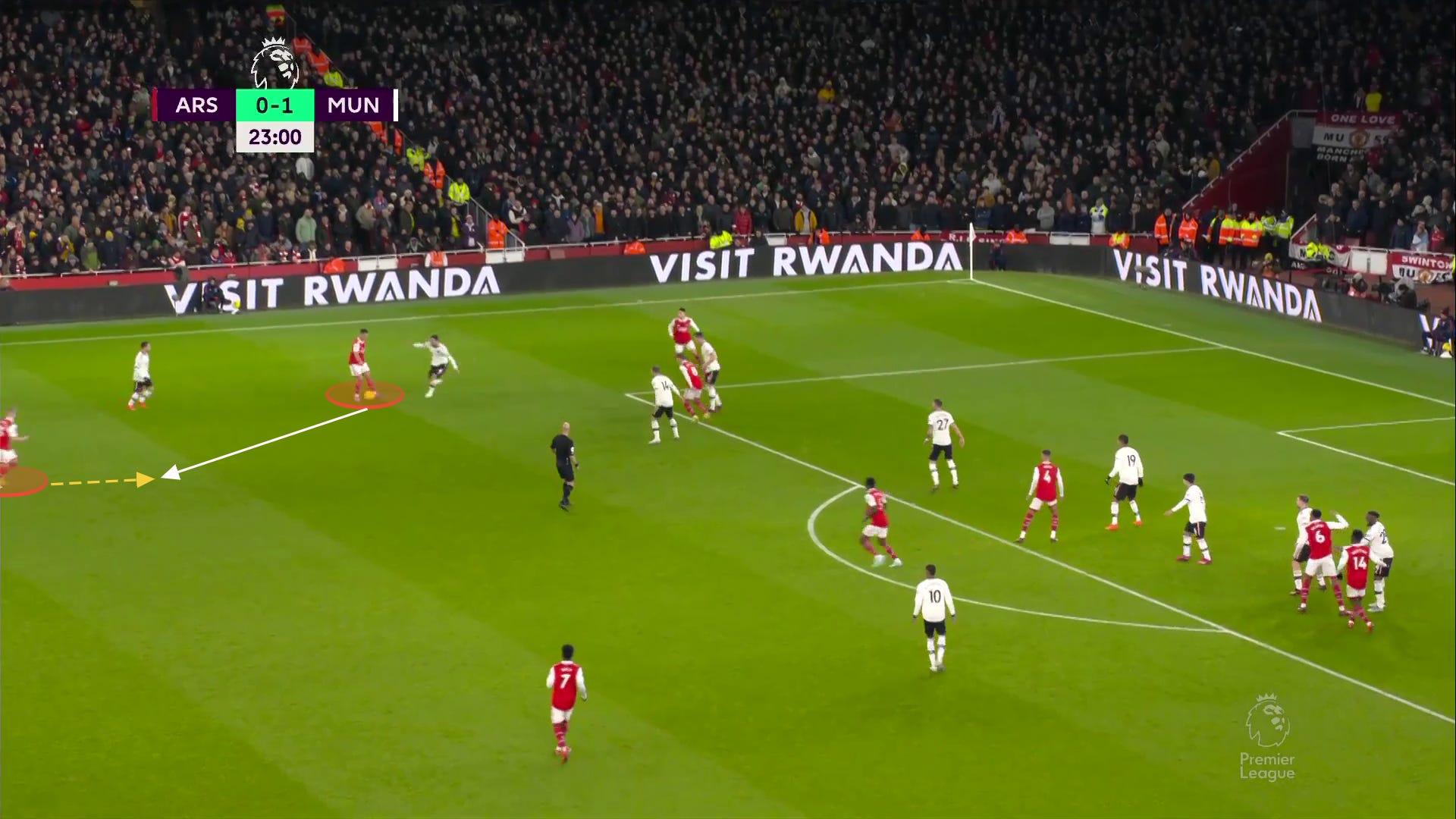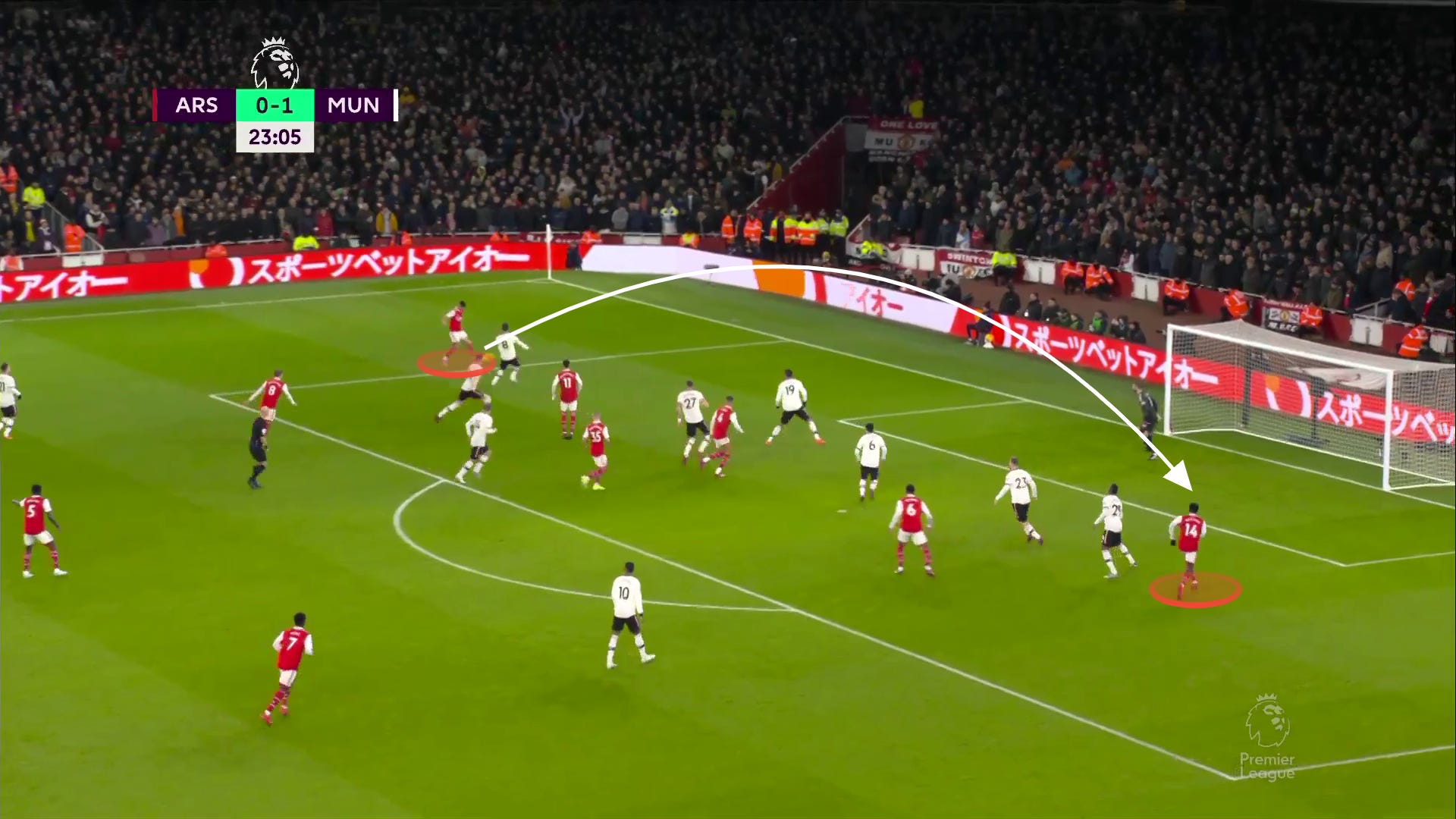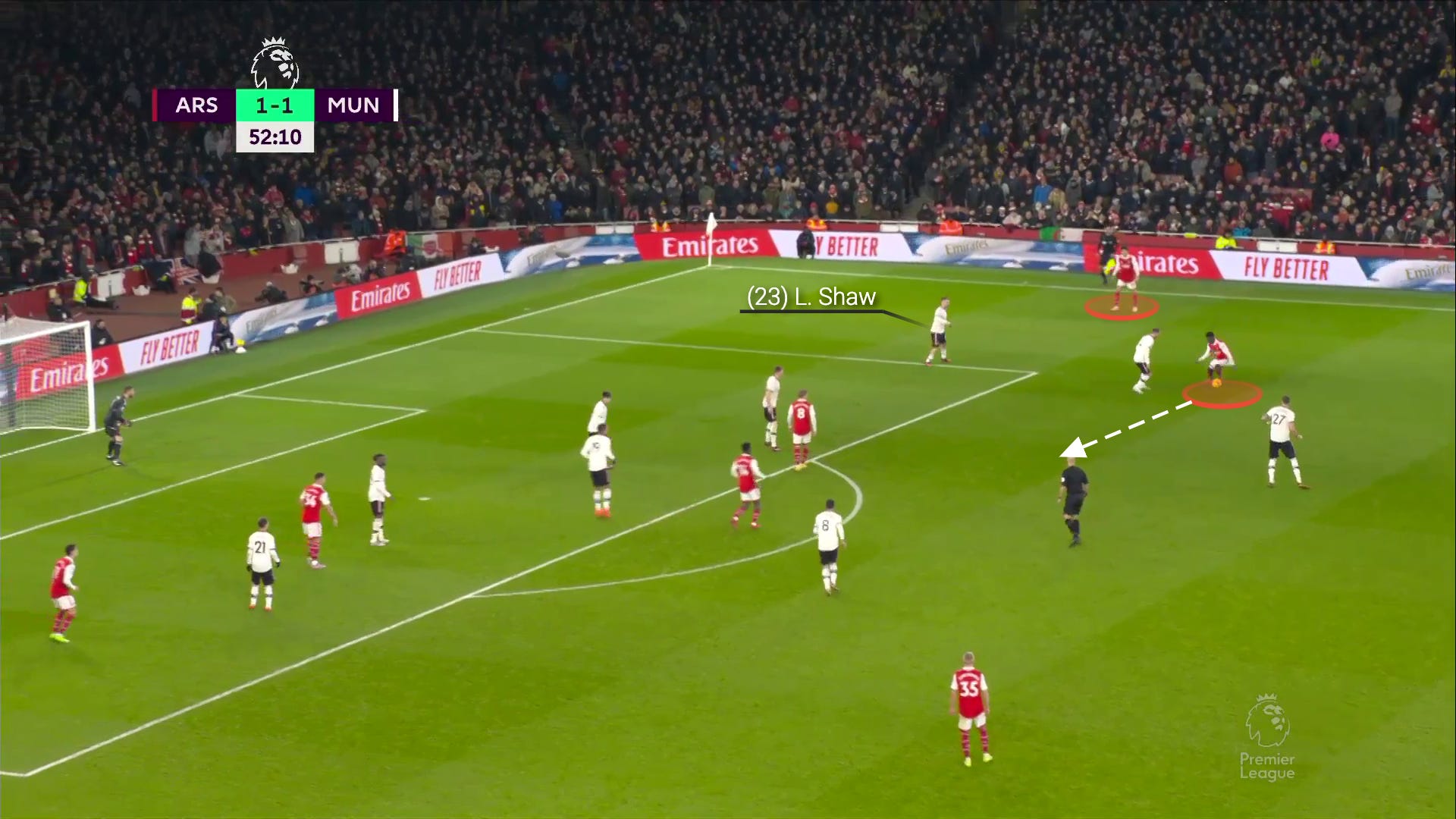Four bits of dubious analysis after a consequential win against Manchester United
On rotations after set pieces, White looking human, Saka’s masterclass, Trossard’s dribbling, and more
If you’re a loser (nay, analyst!) who watches the games twice like me, there’s a familiar experience of late. With the tension of the first viewing melting away, so do any feelings of watching a more evenly-matched affair.
In a game where Arsenal alternated beautiful sequences with a little less security in possession, they notched the highest total touches (63) in an opponent box of any team in any game this season, and wrecked ‘em on virtually any underlying stat, including shots (24 to 5), deep touches (86 to 18), xG (2.5 to .4).
I do believe (and hope) the game finally puts a wrap on any discussion about whether X player should start over Zinchenko for more solidity in the back. My man is simply one of the best in the world at what he does, and if you define defending as “making sure the opponent doesn’t get the ball and/or score goals,” he’s good at that, too.
See:



If Zinchenko is fit, Zinchenko don’t sit. (Unless it’s a cup game or whatever.)
And while there were big headlines coming out of yesterday’s contest—among them, Zinchenko, Nketiah, Saka, and Trossard—I’m not sure I have much to add to all that outside of what I’ve already written. You can read about how Zinny helps Arteta achieve unpredictability; you can read about his similar performance at Brighton; you can read about how it’s Eddie time; you can read about what Trossard will offer.
In the meantime, I thought we’d zoom in on some of the more nuanced parts of the game together. It’ll take the form of a next-day debrief—some positives, some negatives, some ways the team can continue to improve ahead of their first Manchester City matchup. The only difference from a typical team debrief is that, instead of hearing from the coach, you’ll be reading the assorted ramblings of a random guy on his third espresso.
Here are four observations after the game.
1. Taking advantage of every phase of set pieces
With Arsenal likely to face increasingly defensive looks from their opponents, they have to actively pounce every time they face a less well-drilled shape: transitions, field leans, whatever.
For that reason, I’ve been watching the second and third phases of corners with more interest. There are interesting opportunities in the mayhem, with attacking center-backs matched up with defensive strikers and so on. Striker Big Gabi, babyyyy.
Arsenal rightfully likes to keep the pressure up in these scenarios. They scan for opportunity: if an initial corner gets headed away, what does the opponent do? Do they keep man-marking? Do they rush to get back to their spots? Do they start spreading out? Is somebody staying deep, keeping everybody onside?
Arsenal sought to take advantage of these matchups by playing short corners. Early on, despite all the numbers and height in the box, they were able to generate a 4-on-3 out wide. Xhaka cut to wide open grass, and passed it to Partey for a missed shot:
Next, a similar sequence led to the first goal. Said Ten Hag:
"It irritates me immensely how quickly they were allowed to score 1-1. But this fits in the process that we are in."
This goal gives a real sense as to how big of a nightmare the Gunners can be to defend, so let’s walk through how Arsenal created it.
Again after a corner, Zinchenko receives the ball here, on top of a wide diamond. Bruno is on Martinelli wide. Antony is running out to Zinchenko. McTominay runs out of the box and communicates with Eriksen to forget Saliba: his man his now Ødegaard. It’s 4v4:
Zinchenko gives it to Xhaka. Bruno can’t help but shade in to try to dispossess him, and the pass triggers two cuts: one inside by Ødegaard and one outside by Martinelli:
Xhaka ultimately can’t get one of those passes off, so he regroups, and gets it back to Zinchenko:
Zinchenko immediately pushes the issue and creates a body-shape like he’s going into the box with it. This causes Eriksen to cheat inside, opening up a pass back to Ødegaard. Zinchenko gives it to him and cuts towards the box:
And despite all the communication from United, their diamond is now oblong. Antony is effectively taken out of the play, Eriksen is trying to catch up with Zinchenko, and McTominay sees that Xhaka is now free. He motions to Bruno that he should ditch Martinelli and pick up a cutting Xhaka:
Xhaka gets the space he needs for a far-post cross. Wan-Bissaka, despite generally having a good game against Martinelli, can struggle with tracking runners on these, and this may have been something Arsenal targeted. He loses Eddie—who was on fire, and is so good at getting position in times like these. Eddie heads it in:
Now look at all that from one defender’s point of view. In a nine second period, McTominay had to: rotate out of the box to mark Xhaka; communicate to Eriksen to switch back to Ødegaard; shade against simultaneous Martinelli and Ødegaard cuts; switch to Martinelli; switch to Ødegaard; block a lane to a cutting Zinchenko; and finally, communicate to Bruno to switch back to Xhaka before the cross.
Looking through the game again, the team was relentless at attacking after corners and free kicks—and many of the highlights are from such periods.
Arsenal creates tactical overloads for defenders, sure; they also create sensory overloads. Even in a situation where the opponent fared pretty well, Arsenal got the yard they needed to get a cross off to even the game. No wonder Ten Hag is frustrated.
2. White’s humanity, Saka’s brilliance, and holding width on the right
To my eyes, Ben White has been the most consistent player on the team this season. His periods of lower output have been measured in minutes, not games.
At long last, it wasn’t to be against United. He was misplacing passes, and his early (rather clumsy) yellow sapped him of his bullying powers. He wound up losing possession 11 times while only completing 13 passes, and getting the yank at half. It’s good to have depth.
But beyond a simple subpar performance, Ten Hag had a good gameplan against Mr. Blanco, and one I fear that others may seek to replicate.
Looking at how to defend White, a few factors stick out. He’s smart. He isn’t easily flustered or dispossessed. He’s not particularly dangerous on the dribble. If he’s not overlapping, his crosses haven’t been particularly scary, though it feels like he has the talent to be effective there.
His most dynamic contributions, by far, are when passing it to the Saka/Ødegaard duo, or when overlapping around the right. In recent weeks, this rolled pass to Saka has been particularly deadly:
So what did United do? They played off him. When it came time for him to dribble upfield, Eriksen flowed backward to cut lanes off instead of making any pretense of challenging him. He easily picked this one off:
Then, when White was in this corner spot, United didn’t always assign a man his way, effectively challenging him to make something happen. He dropped it off to Ødegaard without attracting somebody to commit towards him:
Let’s compare that to what was happening in the second half (and which White is capable of).
On the right, Saka is always in a favorable matchup, so it’s just a question of degrees. Sometimes, you want to isolate him on the left-back, as you would against a Perisic. Against United, the better matchup is not against Shaw, but Eriksen.
When Saka is the widest player, he’s up against Shaw 1v1. But when Tomi was out there, the matchups change.
Saka’s banger was directly following another corner routine (!) that Xhaka won back. With Tomi holding width, Saka was isolated to get a step on Eriksen. He used the step to good effect, banging in the worldie:
In much the same way, Saka almost scored a carbon copy a little while later.
He still got the better of Shaw a few times, and was isolated on him on plenty, too. In general, though: better matchup, better results.
Regarding White, this isn’t a general concern. He’s been a revelation at right-back, and I think we’re only beginning to understand the true impact of the inverted full-backs in this system. They unlock so many of the special qualities of this team.
That said, teams adapt and counteradapt. The next phase in White’s evolution as a star is going to be personally creating a little bit more fear from his settled position — something that may be informing the pursuit of Iván Fresneda (who is still a ways off). This danger can be created through crosses, dribbles into the box, shots, or just more frequent overlaps. I don’t doubt he’s capable.
3. Trossard and the power of the dribble
It took all of 9 minutes for Leandro Trossard to contribute directly to the title race.
As we covered in the full scouting report, he is incredibly dangerous in the left half-space. While he doesn’t have the high-end speed of a Martinelli, his quick-burst athleticism is really something. To use an NFL analogy, he’s a slot receiver.
After a throw-in, the United shape was leaning towards the Arsenal right. A switch of play meant that Trossard and Zinchenko had it in space. A lesser player would have put a pass to Zinchenko immediately:
Instead, Trossard dribbles to force commitments. Two things are important here: first, he’s good enough to get it done. Second, the defenders know he’s good enough to get it done. Unlike the White scenario above, their fear of his dribbling skill means he generates three commitments in all, which unlocks everything for Zinchenko’s cross:
Xhaka had a pretty immense game, so this is no time to pick nits with him. But with this being the space he usually takes up, it’s fun to imagine having a dribbler in the left-8 in the long-term.
4. Partey’s first half
In the Arsenal shape, there is almost always a back-pass available. The limitations of Sambi and Elneny are not due to their haphazardness, but their safety. They are too likely to play the high-percentage game.
What makes Thomas such a special player is that he values goals more than short-term possession. He is willing to play immediate, line-cutting passes forward if it means a better chance at goal. Then, if the pass goes awry, he’s willing to bet on himself to disrupt the counter, which we’ve seen so many times.
To turn it into a math equation (that I think I’m doing right): If he misses on 14.3% of his passes, then tackles 52.5% of would-be dribblers, that leaves a 6.7% chance that he will both misplace a pass and miss the ensuing tackle. It’s not a perfect summary, as it doesn’t account for help from his teammates from there, or passes he can’t clean up, but it gives you a sense of the basic arithmetic.
Rashford simply put himself into the statistical outlier category because, well, he’s a statistical outlier. He rotated around to block this through-ball, which we’ve seen Partey hit a million times:
Then he somehow got out of this jam, dribbled forward, and blasted a knuckling out-of-box rip in heavy traffic for a goal:
The odds of all this are slim, but that’s the thing about great players. They do not care about your odds.
Because of all this, though, I judge Partey’s game a little bit like a great striker. A role like his can be subject to little spots of variance—a bouncing ball here, an eluded tackle there—but his underlying game winds up looking more similar than different week-to-week.
It wasn’t his best half, but when you play a style like his, in a role as difficult as his, shit happens.
More brilliant analysis from ya boy.
…and finally, the return of Jesus
It’s wonderful that Eddie is getting his long-overdue flowers. He symbolizes everything right about this club. It is, indeed, Eddie time.
It’s a great luxury that the team is not in a position to rush Jesus back, especially with the addition of Trossard. But I also don’t want to lose sight of the player who is arriving when the time comes:
It’s gonna be good.
OK, that’s it for now. Depending on how the news shakes out, I should have another post about potential midfield targets later this week.
Prayers up for David de Gea’s shoulder. 🙏
And happy grilling.
🔥

